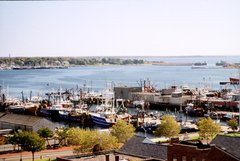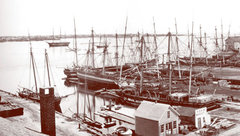New Bedford, Massachusetts
|
|
New_Bedford,_Massachusetts-view_from_harbor.jpeg
New Bedford is a city located in Bristol County, Massachusetts. As of the 2000 census, the city had a total population of 93,768. New Bedford is nicknamed called "The Whaling City" due to the fact that it was one of the most important ports for the whaling industry. The current mayor of New Bedford is Frederick M. Kalisz, Jr.
| Contents |
History
Early history
Up until the 1600s, the only human beings to have lived in the New Bedford area were the Wampanoags, who had settlements throughout south-eastern Massachusetts and Rhode Island, including Martha's Vineyard and Nantucket. Their population is believed to have been about 12,000. While exploring New England, Bartholomew Gosnold landed on Cuttyhunk Island on May 15, 1602. From there, he explored Cape Cod and the neighboring areas, including present-day New Bedford. However, rather than settle the area he returned to England at the request of his crew.
New Bedford was first settled by European settlers in 1652. The land was purchased by the settlers of the Plymouth Colony from chief Massasoit of the Wampanoag tribe. Whether or not the transfer of the land was legitimately done is a matter of debate; the tribe claims that they were unaware at the time that the land would be taken from them permanently. The settlers used the land to build the colonial town of Old Dartmouth (which encompassed not only present-day New Bedford, but also present-day Acushnet, Dartmouth, Fairhaven, and Westport). A section of the colony near the west bank of the Acushnet River, originally called Bedford Village, was officially incorporated as the town of New Bedford in 1787.
The late 18th century would be a time of growth for the town. New Bedford's first newspaper, The Medley (also known as New Bedford Marine Journal), came into being in 1792. In 1794, the town set up its first post office. Most notably though was the creation of a bridge (originally a toll bridge) between New Bedford and present-day Fairhaven in 1796. Fairhaven would later separate from New Bedford in 1812, becoming its own town that included both present-day Fairhaven and present-day Acushnet. The town of New Bedford officially became a city in 1847, with Abraham Hathaway Howland elected as its first mayor.
Immigration in New Bedford
The early 19th century brought with it the immigration of Irish people to Massachusetts. In 1818, immigrants in New Bedford set up a Catholic mission that built St. Mary's Church within the next two years. In the late 19th century, immigrants from Portugal began to make their homes in New Bedford and the surrounding cities. As the Portuguese community began to build, they established the first Portuguese parish, St. John the Baptist Parish, in 1871; the full church would not be completed for another four years. A French community would also come into being in the same decade, building The Church of the Sacred Heart in 1877. As the century came to a close, Polish immigration increased, with its rise marked by the establishment of the parish Our Lady of Perpetual Help in 1903.
African American history in New Bedford
In 1837, Frederick Douglass, a runaway slave who later became a famous abolitionist, settled down in New Bedford. A historical building and memorial dedicated to him exist in the city today. New Bedford was also the home of some members of the 54th Massachusetts Regiment, an American Civil War regiment fighting for the Union and the first ever all-African-American regiment in the country's history. Most famous of these soldiers was William H. Carney, who made sure that the American flag never touched the ground during the attack on Fort Wagner. There is a school named in his honor in New Bedford today.
Geography
New Bedford is located at 41°39'6" North, 70°56'1" West (41.651803, -70.933705)Template:GR.
According to the United States Census Bureau, the city has a total area of 62.2 km² (24.0 mi²). 52.1 km² (20.1 mi²) of it is land and 10.1 km² (3.9 mi²) of it is water. The total area is 16.23% water.
Demographics
As of the censusTemplate:GR of 2000, there are 93,768 people, 38,178 households, and 24,090 families residing in the city. The population density is 1,799/km² (4,660/mi²). There are 41,511 housing units at an average density of 797/km² (2,063/mi²). The racial makeup of the city is 78.86% White, 4.39% African American, 0.62% Native American, 0.65% Asian, 0.05% Pacific Islander, 9.51% from other races, and 5.92% from two or more races. 10.21% of the population are Hispanic or Latino of any race. The ethnic makeup of the city is 38.6% Portuguese, 9.1% French, 8.0% Cape Verdean, 7.9% Irish, 7.3% English, and 7.1% Puerto Rican.
There are 38,178 households out of which 31.2% have children under the age of 18 living with them, 39.5% are married couples living together, 18.9% have a female householder with no husband present, and 36.9% are non-families. 31.6% of all households are made up of individuals and 13.6% have someone living alone who is 65 years of age or older. The average household size is 2.40 and the average family size is 3.01.
In the city the population is spread out with 24.9% under the age of 18, 9.5% from 18 to 24, 28.8% from 25 to 44, 20.2% from 45 to 64, and 16.7% who are 65 years of age or older. The median age is 36 years. For every 100 females there are 89.1 males. For every 100 females age 18 and over, there are 84.4 males.
The median income for a household in the city is $27,569, and the median income for a family is $35,708. Males have a median income of $31,388 versus $22,278 for females. The per capita income for the city is $15,602. 20.2% of the population and 17.3% of families are below the poverty line. Out of the total population, 29.1% of those under the age of 18 and 15.7% of those 65 and older are living below the poverty line.
Economy
The economy of the Pilgrim settlement in the New Bedford area was initially based around a few farming and fishing villages. The early Bedford Village quickly became a commercial zone and from there became a major whaling and foreign trade port. In the early 1700s, the Russell family purchased this area and developed it into the a larger village (Joseph Russell III having made the most significant contributions). By the 18th century, entrepreneurs in the area, such as whaling merchants from Nantucket, were attracted to the village and helped make it into one of the top whaling cities in the country. The most significant of these merchants was Joseph Rotch, who bought ten acres (four hectares) of land in 1765 from Joseph Russell III on which he and his sons ran the family business. Rotch moved his business to New Bedford since it would be better for refining whale oil and manufacturing candles made from whales. As these parts of the whaling industry had been monopolized by a merchant cartel located in Boston, Newport, Rhode Island, and Providence, Rhode Island, Rotch felt that it would be better for business to handle these himself by moving to the mainland.
The relationship between New Bedford and Nantucket allowed the two cities to dominate the whaling industry. In 1848 Lewis Temple invented the toggle harpoon, an invention that would revolutionize the whaling industry. This helped make New Bedford more powerful than Nantucket, thus making it the most powerful city in the whaling industry. As a result of its control over whaling products that were used widely throughout the world (most importantly whale oil), New Bedford became one of the richest per capita cities in the world.
Many whalers would quit their jobs in 1849, though, as the Gold Rush attracted many of them to leave New Bedford for California. During this time Herman Melville, who worked in New Bedford as a whaler, wrote the novel Moby Dick and published it in 1851; the city would be the initial setting of the book. Despite the power it gave to New Bedford, the whaling industry began to decline starting in 1859 when petroleum, which would become a popular alternative to whale oil, was discovered. Whaling in New Bedford eventually came to a halt in 1925, with the last whaling expedition being made by the John R. Manta schooner.
However, New Bedford was able to remain a rich city due to its textile industry. Starting in 1881, the textile industry grew large enough to sustain the city's economy. Over thirty thousand people were employed by the thirty two cotton manufacturing companies that owned the textile factories of New Bedford (which were worth one hundred million dollars in total). Unfortunately, this wealth would disappear from the city when the Great Depression hit the world in the early 20th century.
Sites of interest
New Bedford is the home of The New Bedford Whaling Museum, the centerpiece of the Whaling National Historical Park. It is the country's largest museum on the subject of whaling and the history of interaction between humans and whales.
Transportation
I-195 runs from east to west through the city, as well as US 6. New Bedford is the southern terminus of MA 140, which is highway-grade to MA 24.
The Port of New Bedford is a major fishing port. It also provides ferry service to Martha's Vineyard and Cuttyhunk Island. New Bedford Regional Airport, located in the northern portions of the city, is served by Cape Air with destinations to Nantucket and Martha's Vineyard.
The Southeastern Regional Transit Authority (SRTA) provides mass transportation between the city, Fall River, and the surrounding regions. There are plans by the MBTA to provide commuter rail service to the city. Though there has been some infrastructure work in the region, as of 2005 physical work on the line has not started.
See also
References
- "From Old Dartmouth to New Bedford (http://www.whalingmuseum.org/kendall/old_nb/old_nb_index.html)". WhalingMuseum.org. Retrieved May 21, 2005.
External links
- Official web site of the City of New Bedford (http://www.ci.new-bedford.ma.us/)
- New Bedford Whaling Museum (http://www.whalingmuseum.org/)
- Southeastern Regional Transit Authority (http://www.srtabus.com/)
Template:Geolinks-US-cityscale


